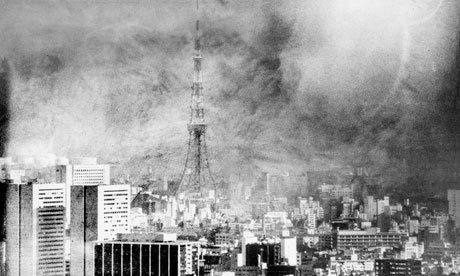
The Japanese photobook is often an art object in itself, merging text, image and design into a unified whole that is often breathtaking in its ambition. Perhaps the most celebrated example is Chizu (The Map) by Kikuji Kawada, an incredibly rare and complex artefact designed by the great Kohei Sugiura. First published in 1965 (on the 20th anniversary of the bombing of Hiroshima) and reprinted by the art publishers, Nasrali, in 2005, The Map is perhaps the ultimate example of photobook as art. At an auction of rare photobooks at Christie's in 2010, a first edition went for over £11,000.
Kawada's photographs of walls, floors and objects scorched by the atomic blast are abstract and grainy, while Sugiura's design is a complex balancing of text and image. The reader must enter and engage with it in a tactile way, opening out the photo spreads as you would a large-scale map, and engaging with every layer of design and meaning. (You can glimpse the complexity of the book here.)
I have already written about another great Japanese photobook, Ravens by Masahisa Fukase, when it was voted the best photobook of the previous 25 years in the British Journal of Photography in 2010. This year, in Tate Modern's big exhibition contrasting the work of William Klein and Daido Moriyama, the latter's prodigious output of photobooks will no doubt form a central part of the show.
Now, Steidl are about to publish Photo Express: Tokyo by Keizo Kitajima, another intriguing photobook albeit of a more raw, confrontational kind. Born in 1954, Kitajima studied photography in a class run by Moriyama in 1975 at Tokyo's Workshop school. The following year, he was one of a group of photographers, including Moriyama and Seiji Kurata, who formed CAMP, an independent photography gallery in Tokyo's Shinjuku district. (Later, in 2001, Kitajima founded the Photographers' Gallery in Tokyo). This new version of Photo Express: Tokyo is a facsimile of a series of 12 booklets he published to tie in with a year-long exhibition of his work at CAMP in 1979.
On the evidence of these photographs, and his approach to exhibiting his work back in 1979, Kitajima applied a punk attitude to the making and disseminating of his work. Back then, he created a new exhibition of his photographs each month, covering every inch of the gallery walls with images, often in grids, of his work from the previous few weeks. He photographed at night, wandering around Tokyo, shooting on the streets, in bars and clubs, capturing the buzzing after-hours energy of the city.
His images are grainy and dark in the manner of Moriyama or Anders Petersen, but even more extreme in their use of contrast and saturation. Sometimes, you have to look hard to see what exactly he has caught, particularly with his super-grainy close-ups of faces and figures: real people blend into billboard figures; others turn away or go about their business oblivious to his camera. There is constant movement. This is wilfully impressionistic street photography that adds up to a blurred portrait of night-time Tokyo, as well as suggesting Kitajima's state of mind at that time.
Each of Kitajima's monthly shows was accompanied by a 16-page booklet, all 12 of which have been reproduced here in all their harsh, grainy glory. They give some sense of the energy and innovation that went into each show, which often included projections and prints pasted on to the gallery walls just hours after the photographs were taken. Sometimes, Kitajima would make the gallery his darkroom, attaching sheets of bromide paper to the walls, projecting images on to them, then applying developer and fixer with a sponge. His methodology was fast, haphazard and alert to all the possibilities of the accidental. The making and showing of the work became a kind of monthly art happening with Kitajima as the restless spirit at its centre.
In many ways, Photo Express: Tokyo is at odds with the tradition of the Japanese photobook as art object: it is almost too energetic, too DIY to stand comparison with art books designed by the likes of Sugiura. All the same, it is an exciting and historically relevant artefact: 12 booklets inside a cardboard cover that hint at the creativity of a true iconoclast of photography who caught the Tokyo night in all its mystery and momentum.
Now see this
Following on from the recent reprinting of the classic book, Les Amies de Place Blanche by the great Swedish photographer Christer Strömholm, Michael Hoppen has a show devoted to the series. These often glamorous portraits of Pigalle's transsexual community in the early 1960s is also a glimpse of often harsh lives lived on the periphery of De Gaulle's conservative society. Beautifully composed and always sympathetic, they remain affecting to this day.

